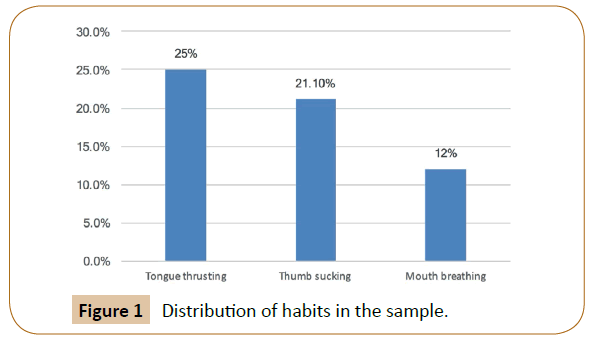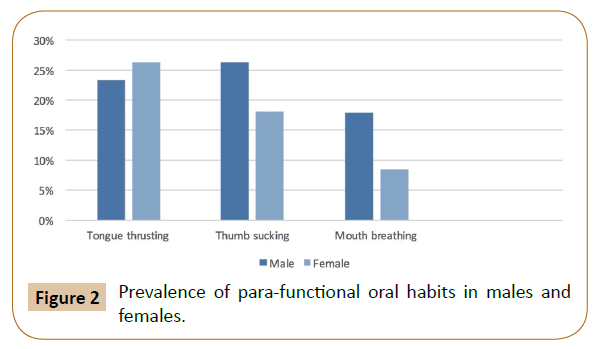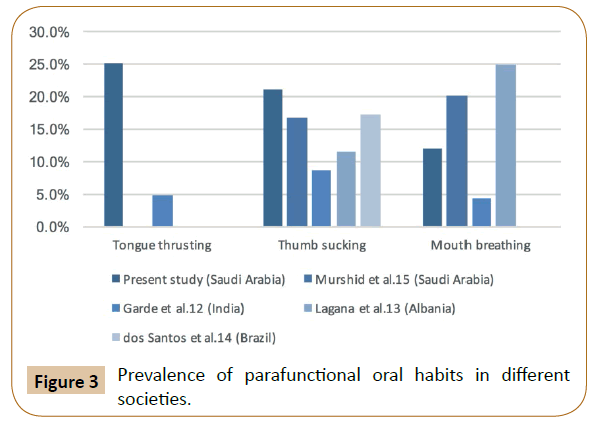Prevalence of Parafunctional Oral Habits in 7 to 15 Years Old Schoolchildren in Saudi Arabia
Arshad A Abbasi, Omar H Alkadhi, Sultan Q AlHobail, Amal S AlYami, Tareq M AlSarhani and Najmah AlMejlad
DOI10.21767/2469-2980.100045
Arshad A Abbasi, Omar H Alkadhi*, Sultan Q AlHobail, Amal S AlYami, Tareq M AlSarhani and Najmah AlMejlad
Riyadh Colleges of Dentistry and Pharmacy, Riyadh, Saudi Arabia
- *Corresponding Author:
- Omar H Alkadhi,BDS, MS
Riyadh Colleges of Dentistry and Pharmacy
Riyadh, Saudi Arabia
E-mail: omar.alkadhi@riyadh.edu.sa
Received Date: July 29, 2017; Accepted Date: August 30, 2017; Published Date: September 05, 2017
Citation: Abbasi AA, Alkadhi OH, AlHobail SQ, AlYami AS, Tareq M, et al. (2017) Prevalence of Parafunctional Oral Habits in 7 to 15 Years Old Schoolchildren in Saudi Arabia. J Orthod Endod. 3:11. doi: 10.21767/2469-2980.100045
Abstract
Objectives: To determine the prevalence of parafunctional oral habits in school children in Saudi Arabia.
Methods: A cross-sectional study conducted in October 2015. Sample included 507 children ranged in age from 7 to 15 years old who were attending private/ government schools in Riyadh, Saudi Arabia using systematic random sampling. Data was recorded by anamnestic questionnaire. Clinical examination was carried out by 6 examiners following WHO guidelines to detect the presence and the type of parafunctional oral habits. Questionnaire included personal data and presence or absence of oral habits like tongue thrust, mouth breathing, and thumb sucking. All examiners took part in a course on the methods of "Functional Analysis" breathing and sucking habits. The interview and examination of a single study subject took 3 to 4 min. Prevalence rates of different oral habits studied were calculated. Chi-square test was done to compare the prevalence of oral habits among different sexes with a cutoff point of (p<0.05).
Results: Sample consisted of 190 (37.5%) males and 317(62.5%) females. Tongue thrusting showed out to be the most prevalent oral habit (25.0%) followed by thumb sucking (21.1%). However, mouth breathing (12.0%) was found to be the least prevalent oral habit. Thumb sucking and mouth breathing was more prevalent in males while tongue thrusting was more prevalent in females.
Conclusion: There is an increased prevalence of oral habits among schoolchildren in Saudi Arabia.
Introduction
It is well established in the literature that parafunctional habits can affect the occlusion increasing the need for orthodontic treatment [1-3]. Moreover, parafunctional habits are reported to be associated with Temporomandibular Disorders (TMD), Burning Mouth Syndrome (BMS), Sleep Bruxism (SB), abfraction, increased overjet decrease in dental arch depth and width, and increased tendency for increased lower anterior facial height [4- 11].
The prevalence of oral habits varied among different societies [3,12-15]. The extent of these effects varies from case to case, depending on a wide range of variables including the actual habit employed, the duration and intensity of the habit, and the inherent dental and skeletal relationship. Some of the negative sequelae associated with prolonged habits like thumb sucking and tongue thrusting include a higher incidence of anterior open bite, maxillary incisor protrusion, class II canine relationship, distal step molar relationship, posterior cross bites, and lip incompetence [16].
Burlington Growth study, which comprised approximately 90% of the pediatric population of Burlington, Ontario, showed that, there was a significant association between the prevalence of class II malocclusion and persisting digit sucking in the different age groups. As the duration of the habit increased, the probability of a child developing a class II malocclusion increased. If the habit was stopped early (before 6 years), the effects on occlusion were often transitory [17]. A study among 832 schoolchildren aged 6-12 years old in Karad district, India, has shown the prevalence of different habits as follows: bruxism (17.3%), bottle feeding (10.1%), thumb sucking (8.7%), nail biting (5.8%), tongue thrusting (4.9%) and mouth breathing (4.3%) [12]. Another study included 2707 schoolchildren aged 7-15 years old from Tirana, Albania has demonstrated the prevalence of oral habits as follows: finger sucking (11.4%), pacifier use (31.8%) and mouth breathing (24.8%) [13]. The prevalence of oral habits among 1385 Brazilian schoolchildren aged 5-6 years old has been reported as follows: pacifier use (43.4%), bottle sucking (84.8%) and finger sucking (17.2%) [14]. Shetty et al. on a study on 6 to 11 year old children in Rajnandgaon city, Chhattisgarh, India has found that the prevalence of tongue thrusting was(17.4%), mouth breathing (13%), and finger sucking (1.7%) [18]. Another study by Jahanbin et al., reported the prevalence of finger sucking on 7-year-old girls in Mashhad, Islamic Republic of Iran to be (10.6%) [19].
In a population of Saudi schoolchildren aged 3-5 years old in Riyadh, Saudi Arabia, the prevalence of sucking habits has been found to be (48.36%) [3]. In a sample of 1032 Saudi schoolchildren and adolescents in Jeddah, Saudi Arabia, it has been reported that the prevalence of breathing problems is (20.2%), bruxism (30.2%), thumb sucking (16.7%) and clenching (13.6%) [15].
The prevalence of oral habits in schoolchildren has not been clearly documented in different population groups across Saudi Arabia. Hence, the aim of this study is to determine the prevalence of oral habits among 7 to 15 years old school children in Saudi Arabia.
Materials and Methods
Ethical approval was obtained from the institutional review board. This cross-sectional study targeted population between 7 and 15 years of age who were attending private/government schools in Riyadh, Saudi Arabia in October 2015. Inclusion criteria included, Saudi children with no systematic diseases or syndromes affecting the maxillofacial area. The total sample included 507 children, both males and females. Study subjects were selected by systematic random sampling. The scheduled activities for recording the data was started after signing informed consent by parents or guardians. Subjects reserved all their rights as stated in the Declaration of Helsinki. The data was recorded by anamnestic questionnaire and clinical examination without radiographs. It was carried out by 6 examiners following WHO guidelines [20].
The detection of the presence and the type of parafunctional oral habit was done in 2 stages: questionnaire and clinical examination. Questionnaire included, personal data, only the presence or absence of oral habits including tongue thrust, mouth breathing and thumb sucking.
Before starting any clinical examination, all the examiners took part in a course on the methods of “Functional Analysis” for breathing, nasal obstruction, sucking habits and biting habits [21,22]. This ensured uniform understanding of clinical methods and application of diagnostic criteria. The intraoral phase of clinical examination was done by using latex gloves, mouth mirrors. A survey proforma was completed by the parents/guardians about the child’s condition related with the manifestations of these habits. The interview and examination of a single study subject took 3 to 4 min. Prevalence rates of different oral habits studied were calculated.
The English questionnaire was translated to Arabic and again retranslated back to English by a bilingual translator. Comparison was done between the original and the retranslated English questionnaire for adjustments of words and phrasing of questions.
Statistical Analysis
Chi-square test of Pearson to determine the difference in the prevalence rate of parafunctional oral habits among different sexes (p<0.05). IBM SPSS version 24 statistical package was used (IBM SPSS Statistics for Mac, Version 24.0. Armonk, NY: IBM Corp.).
Results
Out of the total sample of 507, 190 (37.5%) were males and 317 (62.5%) were females. Table 1 shows the distribution of the sample according to age and gender. Figure 1 shows the prevalence of parafunctional oral habits in the total sample that is representative of the entire schoolchildren in Riyadh, Saudi Arabia in age group (7-15) years old. Out of the 3, tongue thrusting (25.0%) showed out to be the most prevalent oral habit followed by thumb sucking (21.1%). However, mouth breathing (12.0%) was found to be the least prevalent adverse oral habit (Table 2 and Figure 1).
Thumb sucking and mouth breathing was more prevalent in males but tongue thrusting is more prevalent in females as represented in Figure 2. Table 3 shows chi-square statistics of parafunctional oral habits between males and females. No statistically significant difference between males and females in tongue thrust (p=0.447). Thumb sucking and mouth breathing both were more prevalent among males compared to females (p=0.026) and (p=0.002), respectively.
| Total Sample | Composition Sample by Age | Compositions Sample by Gender | ||||
|---|---|---|---|---|---|---|
| Males | Females | Males+Females | Males+Females (%) | Males (%) | Females (%) | |
| Age | n | n | n | |||
| 7 | 7 | 16 | 23 | 4.5 | 30.4 | 69.6 |
| 8 | 7 | 67 | 74 | 14.6 | 9.5 | 90.5 |
| 9 | 21 | 93 | 114 | 22.5 | 18.4 | 81.6 |
| 10 | 29 | 39 | 68 | 13.4 | 42.6 | 57.4 |
| 11 | 39 | 40 | 79 | 15.6 | 49.4 | 50.6 |
| 12 | 67 | 51 | 118 | 23.3 | 56.8 | 43.2 |
| 13 | 18 | 4 | 22 | 4.3 | 81.8 | 18.2 |
| 14 | 0 | 6 | 6 | 1.2 | 0 | 100 |
| 15 | 2 | 1 | 3 | 0.6 | 66.7 | 33.3 |
| 190 | 317 | 507 | 100 | 37.5 | 62.5 | |
Table 1: Composition sample (n=507) by age and gender.
| Habit | Tongue Thrusting | Thumb Sucking | Mouth Breathing |
|---|---|---|---|
| n | 127 | 107 | 61 |
| Percentage | 25.0% | 21.1% | 12.0% |
Table 2: Prevalence of oral habits in total population.
| Habit | Gender | Count | Percentage | P-Value |
|---|---|---|---|---|
| Tongue thrusting | M | 44 | 23.20% | 0.477 |
| F | 83 | 26.20% | ||
| Thumb sucking | M | 50 | 26.30% | 0.026* |
| F | 57 | 18.00% | ||
| Mouth breathing | M | 34 | 17.90% | 0.002** |
| F | 27 | 8.50% |
M: Male; F: Female; *p<0.05; **p<0.01
Table 3: Chi-square statistics comparing males and females for each parafunctional habit.
Discussion and Conclusion
In this study, an attempt was made to examine subjects representing the youth population in the Kingdom of Saudi Arabia. The study sample was evaluated in order to report the prevalence rate of parafunctional habits in Saudi children. In addition to the questionnaires, clinical examination of the children was performed to confirm the presence of parafunctional oral habits and to reduce the tendency to give more socially desirable answers such as denying habits.
The findings of this study are in disagreement with the observations by Guaba et al. who found only 3% of children in the age range of 6-15 years to demonstrate a parafunctional habit as compared to our study that shows the prevalence of parafunctional habits ranged 12.0% to 25.0% in almost the same age group [23]. In the present study, the prevalence of tongue thrusting and thumb sucking were 25.0%, 21.1% respectively, followed by mouth breathing recorded to be 12.0%. Our findings do agree with the observations of Sundaram that mouth breathing was more common in males (7.8%) than females (5.3%) [24]. The findings of the present study contrasts the observations by Shetty et al. that tongue thrusting is more common in boys, although in our study it was found to be more common with females (26.2%) as compared to males (23.2%) [25]. Our study also contradicts the findings of Murshid et al. which shows mouth breathing (20.2%) to be more prevalent than thumb sucking (16.7%), although our study confirms that thumb sucking (21.1%) is more prevalent than mouth breathing (12%). Moreover his findings do not focus on the population suffering from tongue thrusting which, in our study, has been concluded as the most prevalent adverse oral habit in the Saudi population [15]. Figure 3 shows the prevalence of oral habits in different societies.
It has been established that internal worries and lack of deep affections might increase the risk of development of abnormal oral habits. Therefore, maternal deprivation, commonly seen in families with a large number of children could explain the significant increase of nail biting and thumb-sucking in children who had a higher mean number of siblings [26,27]. Also, this was consistent with the increase of abnormal oral habits in children suffering from abnormal psychic stress, such as those whose parents were war prisoners [28]. This was in contrast with finding of Farsi and Salama who reported that sucking habit is related to parents’ education and feeding methods but not related to gender, birth rank, or socioeconomic status [3].
This study was limited by being conducted in only one city in Saudi Arabia. A bigger sample including schoolchildren from all over the country is recommended to better determine the prevalence of parafunctional oral habits.
Conclusion
From the data collected for this study, we found that the prevalence of para-functional oral habits among 7 to 15 years old schoolchildren was as follows:
• Tongue thrusting (25%).
• Thumb sucking (21.1%).
• Mouth breathing (12%).
The results clearly show that the overall rate of para-functional oral habits in the present group of children was high and dictates a need for more studies and prevention strategies.
References
- Warren JJ, Bishara SE, Steinbock KL, Yonezu T, Nowak AJ (2001) Effects of oral habits' duration on dental characteristics in the primary dentition. J Am Dent Assoc 132: 1685-1693.
- Larsson E (1994) Artificial sucking habits: etiology, prevalence and effect on occlusion. Int J Orofacial Myology 20: 10-21.
- Farsi NM, Salama FS (1997) Sucking habits in Saudi children: prevalence, contributing factors and effects on the primary dentition. Pediatr Dent 19: 28-33.
- Cortese SG, Biondi AM (2009) Relationship between dysfunctions and parafunctional oral habits, and temporomandibular disorders in children and teenagers. Arch Argent Pediatr 107: 134-138.
- Motta LJ, Guedes CC, De Santis TO (2013) Association between parafunctional habits and signs and symptoms of temporomandibular dysfunction among adolescents. Oral Health & Preventive Dentistry 11: 1.
- Gao J, Chen L, Zhou J, Peng J (2009) A case–control study on etiological factors involved in patients with burning mouth syndrome. J Oral Pathol Med 38: 24-28.
- Miamoto CB, Pereira LJ, Ramos-Jorge ML, Marques LS (2011) Prevalence and predictive factors of sleep bruxism in children with and without cognitive impairment. Brazilian Oral Research 25: 439-445.
- Sarode GS, Sarode SC (2013) Abfraction: a review. Journal of oral and maxillofacial pathology. JOMFP 17: 222.
- Jalaly T, Ahrari F, Amini F (2010) Effect of tongue thrust swallowing on position of anterior teeth. Journal of Dental Research, Dental Clinics, Dental Prospects 3: 73-77.
- Yemitan T, daCosta O, Sanu O, Isiekwe M (2010) Effects of digit sucking on dental arch dimensions in the primary dentition. Afr J Med Med Sci 39: 55-61.
- Harari D, Redlich M, Miri S, Hamud T, Gross M (2010) The effect of mouth breathing versus nasal breathing on dentofacial and craniofacial development in orthodontic patients. The Laryngoscope 120: 2089-2093.
- Garde J, Suryavanshi RK, Jawale BA, Deshmukh V, Dadhe DP, et al. (2014) An epidemiological study to know the prevalence of deleterious oral habits among 6 to 12 year old children. Journal of International Oral Health 6: 39.
- Lagana G, Masucci C, Fabi F, Bollero P, Cozza P (2013) Prevalence of malocclusions, oral habits and orthodontic treatment need in a 7- to 15-year-old schoolchildren population in Tirana. Prog Orthod 14: 12.
- dos Santos RR, Nayme JG, Garbin AJ, Saliba N, Garbin CA, et al. (2012) Prevalence of malocclusion and related oral habits in 5- to 6-year-old children. Oral Health Prev Dent 10: 311-318.
- Murshid ZA, PHIL M, Abdulaziz AA, Amin HE, Al Nowaiser AM (2007) Assessment of Parafunctional Oral Habits among a Sample of Saudi Dental Patients. Health 12: 13.
- Bishara SE (2001) Textbook of orthodontics. Philadelphia, Saunders, USA.
- Thompson GW, Popovich F (1977) A longitudinal evaluation of the Burlington growth centre data. J Dent Res 56: 71-78.
- Shetty RM, Shetty M, Shetty NS, Reddy H, Shetty S, et al. (2013) Oral habits in children of Rajnandgaon, Chhattisgarh, India-A prevalence study. International Journal of Public Health Dentistry 4: 1.
- Jahanbin A, Mokhber N, Jabbarimani A (2010) Association between sociodemographic factors and nutritive and non-nutritive sucking habits among Iranian girls/Association entre les facteurs démographiques et les habitudes de succion nutritive et non-nutritive chez les fillettes iraniennes. East Mediter Health J 16: 1143.
- Organization WH (2013) Oral health surveys: basic methods. In: World Health Organization.
- Rakosi T, Jonas I, Graber TM (1993) Orthodontic diagnosis.
- Murrieta JF, Hernández DK, Linares C, González MB, Juárez LA, et al. (2014) Parafunctional oral habits and its relationship with family structure in a mexican preschoolers group. J Oral Res 3: 29-35.
- Guaba K, Ashima G, Tewari A, Utreja A (1998) Prevalence of malocclusion and abnormal oral habits in North Indian rural children. J Indian Soc Pedod Prev Dentb 16: 26-30.
- Om PK, Sindhu S, Karimassery SR, Shukla DK (2003) Oral habits in school going children of Delhi: a prevalence study. J Indian Soc Pedo Prev Dent 21: 120-124.
- Shetty S, Munshi A (1998) Oral habits in children–a prevalence study. J Indian Soc Pedod Prev Dent 16: 61-66.
- Jalalian A (1997) The prevalence of thumb sucking and its effects in children aged of six years in Tehran. A Thesis for PhD in Dentistry Dept at Shahid Beheshti Universty 438: 18.
- Finn SB, Akin J (1973) Clinical pedodontics. 4th ed. Philadelphia, Saunders, USA.
- Yassaei S, Rafieian M, Ghafari R (2005) Abnormal oral habits in the children of war veterans. J Clin Pediatr Dent 29: 189-192.
Open Access Journals
- Aquaculture & Veterinary Science
- Chemistry & Chemical Sciences
- Clinical Sciences
- Engineering
- General Science
- Genetics & Molecular Biology
- Health Care & Nursing
- Immunology & Microbiology
- Materials Science
- Mathematics & Physics
- Medical Sciences
- Neurology & Psychiatry
- Oncology & Cancer Science
- Pharmaceutical Sciences



